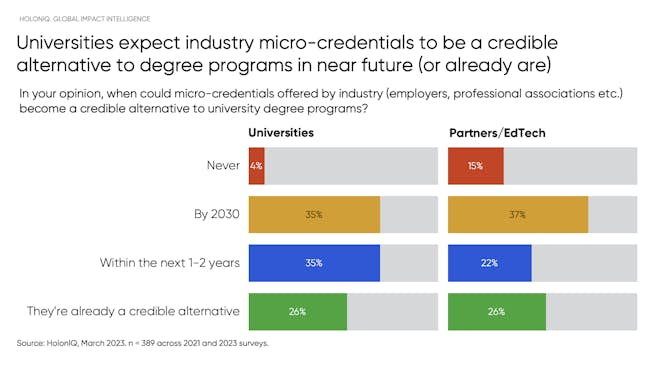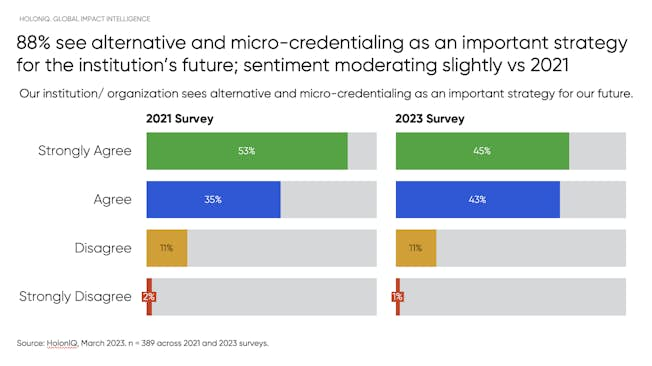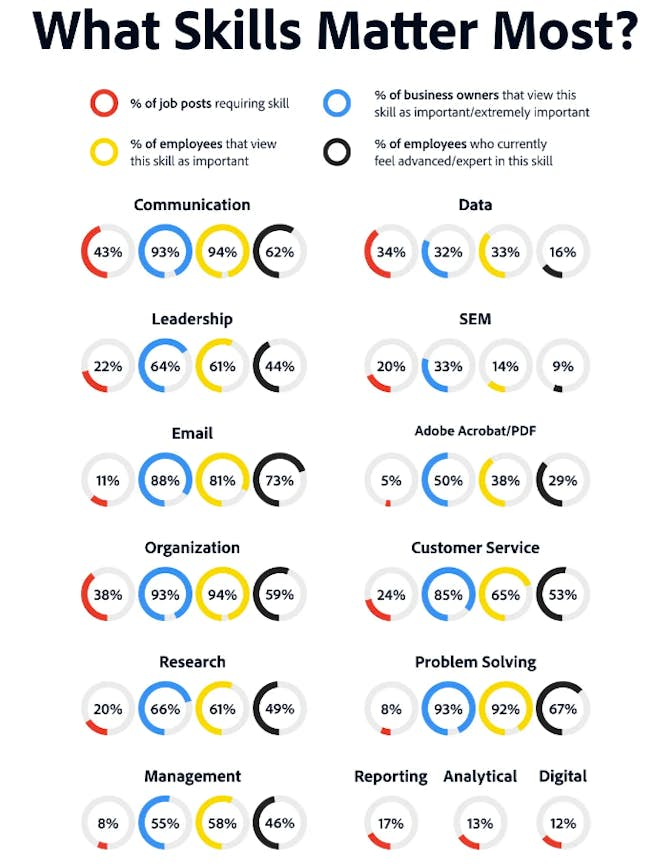Nov 20, 2023
Universities & Colleges: 5 Ways to Boost Student Employability in 2024
While the cost of living soars, so does the cost of higher education. As a result, student enrollments in degree courses are falling like never before in a phenomenon known as the ‘enrollment cliff’.
Employers also report that graduates lack the skills they need in a post-COVID digital world. According to a CMI report, nearly 80% of employers say that current graduates don’t have the skills they need to be work-ready
On the flip side, Cengage research found that nearly half (49 percent) of graduates are not applying for entry-level jobs because they don’t perceive themselves as qualified.
For the higher education sector, it may seem like prospects are dim but that’s not the case. Success will come to those who can bridge the gap between what students learn and what employers need. In other words, demonstrate value and embed career prospects into the curriculum to create work-ready graduates.
In this article, informed by our recent webinar, we’ll reveal 5 effective ways to boost your students’ employability to drive enrollments and elevate brand equity.
1) Offer work-integrated & practical learning
While internships are common as part of a degree program, work-based learning is lacking in many institutions. But this is where the differentiator is for universities and colleges, a USP that students look for to get real-life and hands-on experience in a company.
A great example of using simulations in the classroom is The American Marketing Association which offers programs for professional marketers and research-focused academics PhDs. It also runs simulations at its annual International Collegiate Conference and has experiential learning programs for its student community.
“Simulations are an amazing tool for our students to dig into what work looks like. Curriculums and book learning are great, but really having your students get hands-on experience and know what that entry-level job is going to look like is super vital in 2023 and moving forward,” says Molly Soat, VP of Professional Development at the American Marketing Association.
Other initiatives are entering students into competitions (those involving a corporate sponsor can be very beneficial) and involving them in internal marketing projects so they have experience with CRMs and content creation tools like Canva.
2) Help your students use digital platforms
Digital platforms are an effective way for students to showcase their experience and connect with peers and industry leaders. However, many students need help in this area to build a presence and learn how to use them effectively.
Platforms like the social network LinkedIn and jobs site Indeed are crucial networks for students to be familiar with. But it’s about being clever on those platforms and strategic so when it comes to finding that perfect job, they can be found by recruiters or employers and are ready to apply.
“I always talk to students about thinking like an SEO person with their LinkedIn profile. Go look at the jobs that you want and find the language and the words that are being used in those jobs. Then start to integrate that language and words into your own profile,” says Stephen Marshall, CMO of the ETSU Research Corporate, East Tennessee State University.
Students should also follow companies they aspire to work for and join groups to keep up with trends and developments. Marshall believes the key is to help students be proactive by contacting people who work at companies they are interested in as an employer and asking them how they launched their careers. He advises people to “go view profiles of people that you would like to be like!”
On Indeed, students can learn to use action words and keywords to get found in searches. They can also join networks and follow companies to see what roles are coming up. Uploading a resumé on Indeed is critical as it can help to control what an employer is seeing and tailor it to hit relevant keywords and show real-life experience.
3) Provide your students with industry certifications
With many graduates lacking the skills they need in the marketplace, education institutions need to look at effective ways to align with industry. What they teach needs to reflect what knowledge and skills are needed in the marketplace and with digital marketing, that changes fast.
That’s why a lot of third-level institutions are looking to offer microcredentials and online degrees (or accredited degrees) as a way to fill that skills and knowledge gap. That’s why the online degree and micro-credential market is set to grow to $117 billion by 2025.
For microcredentials, it’s also about the credibility they can bring. It can fill gaps in curriculum that’s out of date or lacking relevance but it can also align a university or college with a provider that has a reputation and brand equity.
“(Offering an industry certification says) we care enough about what we're doing and our university to make sure we're partnering with external organizations to bring the industry into our classroom in a unique and specific way,” says Marshall. “The magic happens when you have an academic institution and an industry partner coming together to really create a unique micro certification partnership.”
35 percent of Universities expect industry micro-credentials to be a credible alternative to a degree program in the next two years according to HolonIQ’s industry report while 24 percent already see them as a credible alternative.

In addition, an overwhelming 95 percent of educators believe micro-credentials are likely to be integrated into most university degree programs. However, a poll by EDUCAUSE shows that only 9 percent of institutions have a mature micro-credential program.

In fact, degree programs and micro-credentials don't have to compete with each other. There is a growing trend that shows higher ed institutions embed micro-credentials (industry certifications) into their programs to elevate the employability of their students and the value of the degree they are offering.
In the introduction, we mentioned the enrollment cliff and it’s coming in 2025. So now is the time to start planning to see how you can offer value to students looking at a degree or course with the eye to kickstarting or advancing their careers.
For the American Marketing Association, microcredentials have helped to advance the careers of professional marketers. AMA has been in partnership with DMI in the professional certification space for years but now that’s expanding. Students enrolled in DMI-accredited higher education programs (in the US) will now graduate with an Associate Level industry certification from both DMI and AMA, in addition to their degree.
“We are thrilled to be offering a microcredential product to students through universities,” says Soat. ”There's such a value in this experiential learning to make your university stand out. Professors, marketing departments and business schools all do an incredible job of transferring that knowledge. It's that combination of employable skills and knowledge that’s really going to make students job-ready.”
You can find out more about this new AMA & DMI microcredential and accreditation here.
“75% of employers say they are more likely to hire candidates that have a DMI certification on their CV” DMI Corporate Skills Gap and Training Survey, 2023
4) Help your students build key soft skills
Soft skills have become increasingly important to employers in recent years. As the demand of the marketplace constantly evolves and the skills required in a business keep changing, companies want employees with skills that can drive change and growth.
So while hard skills like SEO or analytics are still important, employers want employees who are also flexible and able to adapt. According to Adobe research, the skills most in demand by business owners include key soft skills such as communication, leadership, organization, customer service, research and problem-solving.

“Soft skills get built when you get away from lecturing and testing. They get built when you are delivering hands-on experiences. You're allowing students to fail,” says Marshall.
It’s also these types of soft skills that can get a graduate noticed by an employer. However, these types of skills need to be cultivated and nurtured rather than relying on theory or book learning.
Therefore it’s up to educators to give students opportunities to develop these types of skills. That’s where the value of experiential learning and community-based learning really kicks in or initiatives like competitions to nurture leadership or get students involved in team projects to cultivate collaboration and enhance critical thinking.
5) Keep your curriculum relevant & industry aligned
It’s crucial for any university or college to prioritize preparing students for the working world. That’s why it’s necessary to keep your curriculum up-to-date and aligned with the needs of industry.
To keep your curriculum relevant, as a teacher, you need to keep learning and adapting. This means keeping on top of the latest trends, developments, and research in your field and in higher education.
A first step would be to assess your goals and standards. What do you want your students to learn and achieve? What learning outcomes do you want? Is what you’re currently teaching giving students the knowledge and skills they need to get a job? Does your course meet the standards that students and employers require?
Once you have a starting point you can then look to fill the gaps by incorporating new developments and integrating simulations or work-based learning to nurture soft skills. You can also look to use tools such as ChatGPT or email automation to give students real-life skills.
“It’s about incorporating what’s happening in the space, the emerging technologies, and getting students to use ChatGPT if they’re not using it. So students get these experiences because they may be too scared or not informed to jump into the lake and learn how to swim,” says Marshall.
Feedback is also important. Don’t be afraid to ask students - past and present what they think. Do they feel something is missing in what they are learning? Are there areas that need improvement? Do they want more hands-on experience? How do they feel the course prepared them for work?
Never feel that you need to try to achieve this update to your curriculum and industry alignment alone. Collaborate with practitioners and industry influencers to understand what needs to be included to create work-ready graduates.
Offer certifications are informed by experts and constantly updated so your students are learning what they need. This is especially true for digital marketing as the ecosystem keeps changing from search engine algorithms to the impact of AI on SEO.
“It’s about making sure that you have amazing partners like the American Marketing Association and Digital Marketing Institute who can bring all this current information in different ways to thinking to the table,” concludes Marshall.
Boost the value of your digital marketing programs
Find out how to provide your students with a DMI certification or DMI & American Marketing Association (AMA) dual certification (US exclusive) as part of their degree through a DMI University Partnership Program. You can find out more here.
Related
- Categories:
- Articles
- Digital Strategy
Upgrade to Power Membership to continue
your access to thousands of articles, toolkits, podcasts, lessons and much much more.
Become a Power Member- Login
- View Courses
- - - -
- Courses
- Resources
- - - -
- My Account
- Change Password
- Logout




